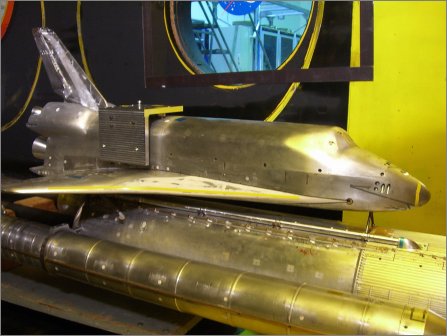Space Shuttle mission gets shunted back to July
Launch of Space Shuttle Discovery/STS-121 has been delayed from May to July because an engine cut-off (ECO) sensor is to be removed from the orbiter’s external propellant tank.
The ECO sensor detects levels of liquid oxygen and liquid hydrogen (LH2) in the ET and a dry reading shuts down the main engines. ECO sensor problems delayed Discovery/STS-114 in July 2005. Before the tank, ET-119, was transported to Kennedy Space Center (KSC) in Florida on 24 February, an ECO sensor in its lower LH2 tank was showing a shift in resistance during testing at NASA’s Michoud Assembly Facility in New Orleans.
|
| A model of the modified shuttle stack has been tested at NASA Ames |
Normally, sensor resistance is changed by the presence of cryogenic fuel and its low temperature. However, resistance changes are also an indication that the sensor’s wire connection could be loose.
ET-119 was transported to KSC while a final engineering decision was made, because it is easier to replace the sensor when the tank is in the vertical position at KSC’s vehicle assembly building.
NASA is to use the additional 14 weeks to the new launch date to analyse other engineering issues and conduct windtunnel testing of the changed ET design and the entire Shuttle stack.
“We have the [Shuttle] models fabricated and we are gathering data [on the new tank] for a good determination of safety for the new design. I remain optimistic we will be able to achieve three missions this year,” says NASA Space Shuttle programme manager Wayne Hale. Discovery was to carry out an International Space Station supply mission during the original 10-22 May launch window.
The next window is 1-19 July. That is because NASA is requiring a daylight launch for STS-121 and Atlantis/STS-115, the next missions in its programme.
In the unitary windtunnel complex at NASA Ames Research Center, California, a 3% scale model of the modified Shuttle stack has been run through Mach 1.5-2.5 tests in the 2.8 x 2.1m (9 x 7ft) windtunnel and a follow-on set of tests in the larger 3.4 x 3.4m tunnel at M0.2-1.5.
The ET has had foam removed from certain areas to reduce the threat of foam loss, which could strike the orbiter during launch.
After the July window, the next two launch opportunities are in August and November.
ROB COPPINGER / LONDON
Source: Flight International
























